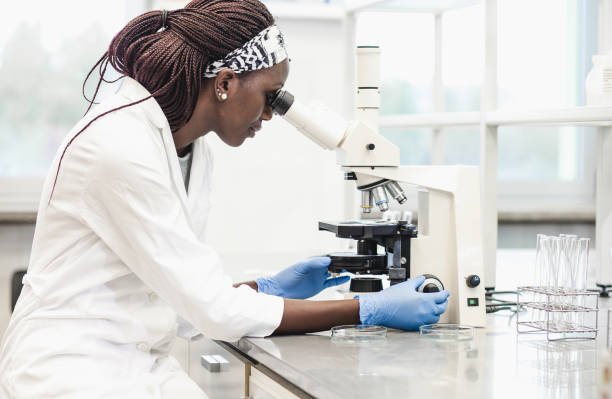By Gustav Addo
An ancestry test, also known as a genetic ancestry test, analyzes a person’s DNA to determine their genetic makeup and provide estimates of their ancestral origins. These tests compare your DNA to a database of known ancestries to identify shared genetic markers and estimate the percentage of your DNA that originated in different geographic regions.
A genealogical DNA test is a DNA-based genetic test used in genetic genealogy that looks at specific locations of a person’s genome in order to find or verify ancestral genealogical relationships, or (with lower reliability) to estimate the ethnic mixture of an individual. Since different testing companies use different ethnic reference groups and different matching algorithms, ethnicity estimates for an individual vary between tests, sometimes dramatically.

For centuries, people of African descent have been scattered across continents through migration, displacement, and the devastating transatlantic slave trade. With this scattering came a painful loss—of languages, traditions, identities, and most importantly, a sense of ancestral belonging. In today’s age of technology and genetic science, we are presented with a powerful tool to begin restoring what was broken: ancestry testing.
1. Reconnecting with a Lost Heritage
Unlike many other ethnic groups who can trace their roots back for generations, millions of Africans in the diaspora—especially in the Americas and Caribbean—were systematically stripped of their family names, tribal affiliations, and ethnic identities. An ancestry test provides a unique opportunity to rediscover those lost connections. Knowing that your lineage ties to the Yoruba of Nigeria, the Akan of Ghana, or the Bantu-speaking peoples of Central Africa offers a sense of pride and belonging no textbook or documentary can replicate.
2. Promoting Pan-African Unity
Ancestry testing reveals the diverse but interconnected ethnic roots of African-descended people. Instead of viewing ourselves through the narrow lens of national or colonial identities (Jamaican, African-American, Haitian, British-African, etc.), we begin to see the deeper, older bonds that unite us. Shared ancestry can ignite a renewed sense of Pan-Africanism—reminding us that we are not strangers to one another, but kin separated by circumstance.
3. Healing Historical Wounds
The traumas of slavery and colonization still echo in modern systems of racism, inequality, and identity fragmentation. Knowing your ancestry can be an act of healing. It’s a step toward reclaiming stories and legacies that were deliberately erased. For many, discovering the names, customs, and places of their forebears replaces shame with pride, and confusion with clarity.
4. Strengthening Cultural Revivals and Traditions
Once armed with knowledge about their roots, many individuals go on to learn indigenous languages, adopt traditional names, participate in rites of passage, or even travel to their ancestral homelands. Cultural revival becomes more than abstract nostalgia—it becomes personal, vibrant, and empowering.
5. Driving Economic and Political Engagement with Africa
When African-descended people in the diaspora discover direct ties to countries and regions on the continent, many are inspired to invest, build, and engage more deeply with African development. This can catalyze powerful collaborations in tourism, agriculture, arts, technology, and activism—bridging the gap between Africa and its global diaspora.
6. Creating a Digital Archive of African Lineages
The more African-descended people participate in ancestry testing, the richer the genetic databases become. This helps scientists, genealogists, and historians piece together Africa’s vast and complex population histories. Each test becomes a puzzle piece in reconstructing the great mosaic of African civilization, contributing to a shared narrative that is inclusive, scientific, and empowering.
Here is the personal testimony of Brian Copperwood (A 46 year old African-American)
“I was captivated. In a sense it was a shock, I was 20 percent Ghanaian/Ivory Coast, 20 percent Cameroon Congo, 18 percent Nigerian, 13 percent Benin/Togo, 7 percent Southeast Bantu (includes East African nations, but also the Congo, Angola, and Southeast Africa), 6 percent Senegal/Gambia, 4 percent Malian, and less than 1 percent Africa South Central Hunter Gatherer (the Pygmies of Congo and South Africa).
Most of these places are from West and Central Africa, where we know a substantial portion of slaves were brought to the Americas (although I know they weren’t by these names). I am also 8 percent European (Six percent British, 1 percent Swedish, and 1 percent Irish which isn’t shock because slave masters would often rape their slaves). Several of my great, great, great grandparents were listed as mulattoes on various censuses. Yet, I am still less white than the majority of African Americans who range between ten and twenty percent European. I was also less than one percent Native American (this wasn’t a shock though I expected myself to show up about one or two percent), less than one percent East Asian which was shocking at first (on the update this was refined to Southeast Asian/Vietnamese which makes since considering the Malagasy from Madagascar were sometimes brought as slaves and they were a mix of East African and Southeast Asian ancestry). I was also less than one percent Middle Eastern, which was shocking, but not overly so. Many West Africans have deep Middle Eastern roots. All in all, I was fascinated, proud, and confused regarding some of my smaller ancestral regions until I realised these were historically plausible and very likely accurate. I highly encourage people to take a test. Just don’t seek to appropriate anyone’s culture, but there’s nothing wrong with embracing your ancestry. As an African American, this knowledge was taken from my people, but DNA tests are great for helping to fill in missing links and add to our sense of self. www.quora.com
Doing your Ancestry Test
Three principal types of genealogical DNA tests are available, with each looking at a different part of the genome and being useful for different types of genealogical research: autosomal (atDNA), mitochondrial (mtDNA), and Y-chromosome (Y-DNA).
Here is how you can have your Ancestry test done:
- You typically provide a saliva sample or a cheek swab, which is then sent to a lab for analysis.
- The lab extracts your DNA and identifies specific genetic markers or sequences.
- The lab compares your genetic markers to a database of DNA profiles from individuals with known ancestries.
- Based on the matches, a computer program calculates the percentage of your DNA that likely originated in different geographic regions.
- You receive a report that shows an estimated breakdown of your ancestral origins, often presented as a pie chart or a map showing where your DNA came from.
Some tests also offer additional features like finding DNA matches with other individuals, exploring family history records, or examining specific genetic traits.
Our Blood Holds Stories Worth Telling
Ancestry tests are not just about science—they are about identity, reclamation, and healing. For people of African descent, whose pasts have often been distorted or erased, these tests are a form of quiet revolution. They enable us to write new chapters in our personal and collective histories—with dignity, knowledge, and power.
It’s time we stopped viewing ancestry tests as a novelty. For us, they should be a necessity.




